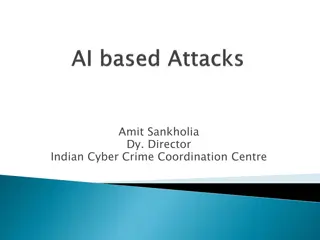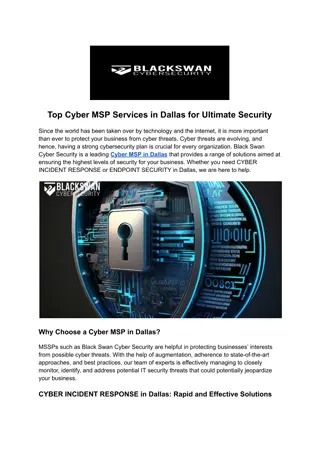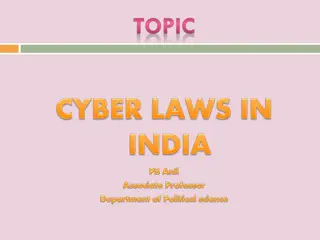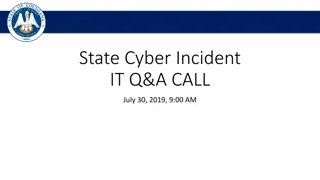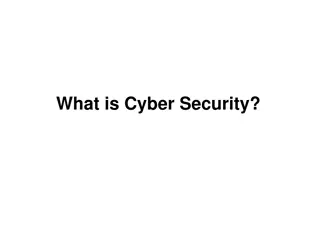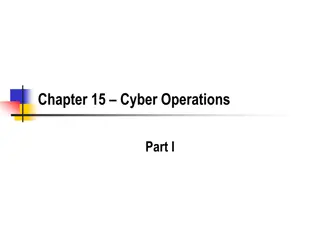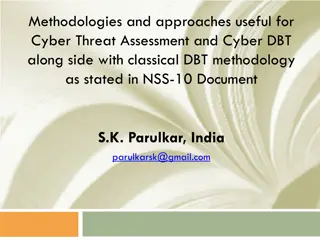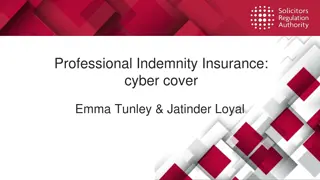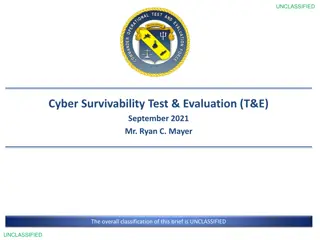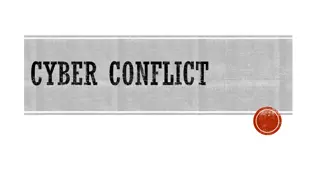Understanding Cyber Conflict Fundamentals and Policy Framework
Cyber conflict involves defensive and offensive cybersecurity measures, with the need for comprehensive policy frameworks to guide the use of offensive capabilities. Governments must establish guidelines comparable to those for police officers carrying guns, covering doctrine, training, rules of engagement, command and control, identification, liability, and insurance.
Download Presentation

Please find below an Image/Link to download the presentation.
The content on the website is provided AS IS for your information and personal use only. It may not be sold, licensed, or shared on other websites without obtaining consent from the author. Download presentation by click this link. If you encounter any issues during the download, it is possible that the publisher has removed the file from their server.
E N D
Presentation Transcript
Fundamentals of Cyber Conflict Herb Lin Stanford University CS-203 May 23, 2017 5/23/2017 1
Some source material 5/23/2017 2
Policy and Technology Framing 5/23/2017 3
A fundamental distinction Cybersecurity vs cyber security Cybersecurity: security of cyber things (computer and communications technology systems) as proper system operation even under conditions of threat Cyber security: security of cyber domain as in national security : the ability to preserve the nation's integrity and territory; to maintain its economic relations with the rest of the world on reasonable terms; to preserve its nature, institution, and governance from disruption from outside; and to control its borders (Harold Brown, fmr SecDef) 5/23/2017 4
A basic premise Cyber conflict and cyber security have both defensive and offensive dimensions, and comprehensive approaches require understanding both. Defensive cybersecurity (very public) Passive defenses Anti-virus and intrusion detection software Better password security Greater attack resistance in software More robust law enforcement mechanisms e.g., Convention on Cybercrime Offensive cybersecurity (usually classified) Offensive operations can be used for defensive purposes. Offensive operations can be used for non-defensive purposes. 5/23/2017 5
Governments need policy to guide use of offensive capabilities If police officers carry guns, policy must address: Doctrine: general guidance about the circumstances in which the use of lethal force might be necessary Training: how to use guns Standing rules of engagement (SROE): in detail, under what circumstances to use guns Command and control: exceptions to SROE re use of guns Identification friend-or-foe (IFF): how to distinguish between bad guy and police/innocent bystanders Liability and insurance: responsibility for mistakes The intent of allowing police to carry guns is defensive. Bad guys rarely need to worry about these issues. 5/23/2017 6
What is a gun in cyberspace? Cyber weapon: instrument used to create bad effects against adversary computer Destroy data/program Render it inaccessible Steal data Harm devices attached to computers 5/23/2017 7
Basic technology of cyber weapons Cyber weapon: instrument used for hostile or unfriendly purposes against adversary computer Aspects of a cyber weapon Access Vulnerability Payload Penetration Cyber weapon is not a particularly good term, but no better term available. 5/23/2017 8
Access Technical Remote (through the Internet) Close-access (e.g., through chip swap, USB key, supply chain, tapped cable, clandestine WiFi, burglary, shipping) Social Trickery, bribery, blackmail, extortion, persuasion Some targets of social access Users and operators Vendors and service providers Technical and social elements often combined, e.g., phishing. 5/23/2017 9
Vulnerabilities Software (application or system software with accidentally or deliberately introduced flaws) Hardware (microprocessors, graphics boards, power supplies, peripherals, storage devices, network cards). Communications channels (e.g., tap on fiber optic line) Configuration (e.g., ports improperly left open, weak passwords allowed) 5/23/2017 10
Payload determines type of offensive action Attack: degrade, disrupt, destroy, deny system/network or information therein Integrity (data/operations are altered includes botnet, self-destruction of computer, change data) Authenticity (data/operations are forged) Availability (data/operations is inaccessible) Exploitation (surreptitiously exfiltration of confidential information) Note that attack and exploitation use the same access paths to take advantage of the same vulnerabilities only payloads are different. How does victim distinguish between the two? 5/23/2017 11
Cyber operations vs cyber weapons Offensive cyber operation requires cyber weapons, people, planning, goals, command and control, rules of engagement. Weapons provide offensive capabilities (enable offensive action), which can be used for offensive or defensive purposes. Offensive capabilities are hostile (destroying, damaging, degrading, disruptive, denying) and act on a technological artifact Defensive capabilities prevent or mitigate destruction, damage, degradation, disruption, denial Offensive purpose disadvantages adversary, advantages self Defensive purpose protects interests of self; maintains status quo. 5/23/2017 12
Some cyber examples Offensive purpose Cyber attack to degrade infrastructure for adversary nuclear capability (R&D) (Stuxnet) Defensive purpose Cyber attack to take out botnet controllers (sometimes with court approval) Offensive capability (destroy, degrade, disrupt, manipulate, deny) Defensive capability (prevent use of offensive capability) Encryption used to hijack data for ransom Encryption used to ensure confidentiality of private data 5/23/2017 13
Some important characteristics of offensive cyber capabilities Cyber is offense-dominant in most situations The only perfectly secure computer is useless. The enormous complexity of modern information technology means that there are multiple places where an adversary can intervene, and often only one intervention is necessary. Given enough time, the offense will always be successful. When timetable is determined by external events and coordination is necessary, success is harder to achieve. 5/23/2017 14
Offensive capabilities span a very large range Very destructive to nondestructive Very selective to not selective Immediate execution to long-delayed execution Offensive operations can be conducted with plausible deniability in the short term, but Attribution may be possible in the long term, drawing on all sources of intelligence. Usually no smoking guns. Kinetic forces also can operate with deniability. 5/23/2017 15
A given offensive cyber operation may be: Known only long after penetration has occurred Limited in utility: usable only once or a few times Fragile: usable only as long as intelligence is valid Technically fast but operationally slow; hence most suitable in nonurgent scenarios (e.g., early use); speed of light vs speed of law Planning is both critical and hard Large range of options than most traditional military operations Many possible outcome paths very specialized knowledge Cascading effects, collateral damage estimates, damage assessment all hard to perform 5/23/2017 16
Intelligence support for cyber operations is critical Must be accurate, detailed, timely (esp. if targeted) Intelligence gathering requires much advance planning (can be years!) Intelligence is fragile (e.g., depends on updates being installed) Adversary can take steps to invalidate intelligence if aware of need. Needs for intelligence creates pressures for early use 5/23/2017 17
Two different kinds of offensive cyber capability Cyberexploitation (surreptitiously obtain confidential information aka espionage) Cyberattack (degrade, disrupt, destroy, deny system/network or information therein) Integrity (data/operations are altered includes botnet, self-destruction of computer, change data) Authenticity (data/operations are forged) Availability (data/operations is inaccessible) Hostile actions involve penetration and payload. Penetration enables hostile action Payload specifies what hostile action to take 5/23/2017 18
Some ways to use offensive cyber capabilities 5/23/2017 19
Offensive actions for defensive purposes Before adversary attack Pre-empt offensive cyber action about to be undertaken by adversary Provide early warning of adversary cyber attack (must penetrate adversary networks before tactical threat emerges) During adversary attack Disrupting a cyberattack in progress by disabling the attacking computers After adversary attack Need for conducting forensic investigation (exploitation) Retaliatory attacks to discourage further attacks . 5/23/2017 20
Offensive actions for offensive purposes Traditional military operations Suppression of adversary weapons (e.g., air defenses). Interference with adversary command and control Disruption of logistics chains Nontraditional operations (aka covert action ) Influencing the outcome of a foreign election (hacking voter registration, destroying pension records, conducting information warfare) Destabilizing a nation through attacks on the financial system. Damaging an adversary s nuclear weapons production facilities Damaging personal reputation of adversaries, manipulating perceptions 5/23/2017 21
Attacks on critical infrastructure Some elements Power grid Transportation (e.g., air traffic control) Financial infrastructure Communications Most concerns expressed over large-scale damaging attacks with long-lasting effects EMP burst could have such effects Hard to imagine other kinds of cyberattacks with such effects Attacks of concern *should* include small- scale attacks with large impacts on public confidence. 5/23/2017 22
Foreign intelligence and espionage National security intelligence gathering/espionage Diplomatic information Negotiation positions Political plans Military information Personnel information Economic espionage product development and use manufacturing procedures business plans, policy positions and analysis emails of high-ranking employees; A slow bleed of large significance because of scale, but many numbers estimating economic value of loss are suspect 5/23/2017 23
Domestic intelligence . Coals to Newcastle Key issues Scope, scale, nature of desired intelligence gathering Appropriate distinctions, if any, between foreign and domestic collection Appropriate legal authorization (and enforcement) Scope, scale, nature of infrastructure needed (nonconsensual surveillance requires more than consensual) 5/23/2017 24
Punching or punching back? Punching back unlikely to work very well Pre-emption require ubiquitous presence and automated decision making Disruption requires instantaneous identification of attacking computers and won t harm actual perpetrators. (Also raises questions of attacks on computers belonging to US citizens.) Retaliation doesn t have to be in cyberspace or against the attacking computers Retrieving or destroying stolen information likely to be futile as copies will be made. 5/23/2017 25
But punching (not punching back) doesnt require tight timelines. Ideally suited for first use May be less provocative than kinetic action Plausibly deniable, at least in short run Harm may be decoupled from mechanism of action and hence harder to find problem and to take countermeasures Ideally suited for covert action intended to weaken adversaries 5/23/2017 26
US views on cyber 5/23/2017 27
Excerpt from DOD Cyber Strategy: US Strategic Goals Build and maintain ready forces and capabilities to conduct cyberspace operations; Defend the DoD information network, secure DoD data, and mitigate risks to DoD missions; Be prepared to defend the U.S. homeland and U.S. vital interests from disruptive or destructive cyberattacks of significant consequence; Build and maintain viable cyber options and plan to use those options to control conflict escalation and to shape the conflict environment at all stages; Build and maintain robust international alliances and partnerships to deter shared threats and increase international security and stability. 5/23/2017 28
On offensive operations in the DOD Cyber Strategy OCOs will be conducted in accordance with the laws of war Targets of OCOs include adversary command and control networks, military-related critical infrastructure, and weapons capabilities. OCOs may be conducted during periods of heightened tension (i.e., before the outbreak of outright hostilities). Offensive capabilities with significant effects exercised on NCA determination for disruption of an adversary s military related networks or infrastructure so that the U.S. military can protect U.S. interests in an area of operations. Examples: Conflict termination on U.S. terms Disrupt adversary military systems to prevent the use of force against U.S. interests. Deter or defeat strategic threats in other domains working with other USG agencies. DOD concerned only with responding to attacks of highest consequence. 5/23/2017 29
PPD-20 (still classified may not survive Trump admin) Directs relevant agencies to start assembling a list of potential targets of national importance for OCO Requires specific presidential approval for offensive operations with significant consequences loss of life significant responsive actions against the United States significant damage to property serious adverse U.S. foreign policy consequences serious economic impact on the United States. DOD acknowledges use of cyber weapons against ISIS 5/23/2017 30
The IC view of offensive operations Signals intelligence is intelligence derived from electronic signals and systems used by foreign targets, such as communications systems, radars, and weapons systems. (www.nsa.gov) U.S. government agencies collect and analyze SIGINT to assist U.S. policy and decision makers. SIGINT is governed by US law, Presidential executive order, and regulation to protect the rights of U.S. citizens (persons). Non-US persons have no (very few) rights under U.S. policy. EO 12333 tasks CIA with covert action, which may include offensive cyber operations. 5/23/2017 31
International humanitarian law (the laws of armed conflict) 5/23/2017 32
What is cyber war? Why is a definition of cyber war necessary? To know when the Article 51 threshold of armed attack has been crossed? To know when 2(4) prohibition on use of force has been violated? To know when IHL must be invoked? Two cases of interest: Offensive cyber operations being conducted as part of a traditional armed conflict using kinetic weapons intended to cause kinetic-like effects. Offensive cyber operations being conducted without the contemporaneous use of as part of a traditional armed conflict using kinetic weapons intended to cause sub-threshold effects 5/23/2017 33
What is not cyber war? A teenager defacing a DOD/MOD web site. A person hacking into the bank accounts of a defense contractor to steal money. An unfriendly nation stealing plans for a new jet fighter. A terrorist group using the Internet for recruiting, fund raising, propaganda, and communications. Dividing lines between criminal acts and acts that might implicate the UN charter or IHL are unclear. Many examples of cyberattack; few (if any) examples of cyber war. Responses to hostile subthreshold actions are the most immediately relevant dimension of policy today. 5/23/2017 34
Worldwide Threat Assessment of the US Intelligence Community, 2015 [T]he likelihood of a catastrophic [cyber] attack from any particular actor is remote at this time. Rather than a Cyber Armageddon scenario that debilitates the entire US infrastructure, we envision something different. We foresee an ongoing series of low-to-moderate level cyber attacks from a variety of sources over time, which will impose cumulative costs on US economic competitiveness and national security. Cyber is the first-mentioned item on the list of threats faced by the United States (and hence understood to be the most significant). 5/23/2017 35
Key terms in UN Charter (bolded below) not defined UN Charter prohibits threat or use of force against the territorial integrity or political independence of any state (Art. 2(4)) Force not defined. By practice, it includes conventional weapon attacks that damage persons or property excludes economic or political acts (e.g. sanctions) that damage persons or property UN Charter Art. 51 - Nothing in the present Charter shall impair the inherent right of individual or collective self-defence if an armed attack occurs against a Member of the United Nations.. Armed attack not defined, even for kinetic force. Relatively easy: If cyberattack causes effects comparable to that of a kinetic attack, it should be treated the same way (at least an effects-based analysis). Damage to air traffic control, dams, nuclear reactors that cause significant death/destruction are armed attacks. Relatively hard: If cyberattack causes other effects (e.g., long-term disruption to critical infrastructure or stock exchanges) without immediate large-scale death or destruction of property), legal status is unclear. 5/23/2017 36
Jus Ad Bellum - UN Charter UN Charter prohibits threat or use of force against the territorial integrity or political independence of any state (Art. 2(4)) UN Charter Art. 51 - Nothing in the present Charter shall impair the inherent right of individual or collective self-defence if an armed attack occurs against a Member of the United Nations.. UN Charter written in 1945, long before cyber. Bolded terms not defined. 5/23/2017 37
Hard scenario 1: Economic damage without physical damage Banking and financial systems are heavily dependent on computer and communications technology. Zendia launches an attack against the banking systems of Elbonia in which national accounts were manipulated in order to cause significant financial instability in Elbonia, resulting in panic and a loss of confidence in the Elbonian population. 5/23/2017 38
Hard scenario 2: Interfering with elections Civilian IT systems are generally not well-defended. A Zendian cyberattack is used to hack the electronic voting machines used in a close Elbonian election, thus tilting the election to the party favored by Zendia. A Zendian cyberattack corrupts the pension records of millions of people in Elbonia. In the next election, the ruling party in Elbonia (disfavored by Zendia) is voted out of office because of the resulting scandal. 5/23/2017 39
Hard scenario 3: Ambiguities between exploitation and attack International law does not prohibit intelligence collection by spies, and cyber exploitation is not illegal under international law. Zendia conducts repeated and continuing probes of Elbonian military and defense industry networks, exfiltrating classified and unclassified data on a large scale. Is this a threat of force? Zendia introduces Trojan horse agents into Elbonian military and infrastructure computer systems that exfiltrate data and also have a capability of being upgraded remotely. Is this a threat of force? Zendia introduces Trojan horse agents into Elbonian military and infrastrcture computer systems that only have a capability of being upgraded remotely. Is this a threat of force? 5/23/2017 40
Jus in Bello - Some ImportantPrinciples Principle of Proportionality Collateral damage on civilian targets acceptable if not disproportionate to the military advantage gained. Principle of Distinction Military operations only against military objectives and not against civilian targets Only military personnel can directly participate in hostilities 5/23/2017 41
On proportionality Definition of inadvertent harm to civilians in cyberattack? NO - Mere inconvenience. YES - Death on a large scale. MAYBE the inability to conduct financial transactions electronically, periodic interruptions in electrical power, major disruptions in travel and transportation schedules, outages in communications capability. Example case: A botnet uses compromised computers to conduct attacks. If a compromised computer is 99.99% functional for the user, is it collateral damage? 5/23/2017 42
On distinction Targeting only military objectives Knowing that a given computer is a valid military target may be difficult and highly uncertain. How should a cyber attacker differentiate military and civilian computers? (Does defender have responsibility to help differentiate?) Targeting dual-use infrastructure Communications facilities Electric grid Financial network High degree of entanglement of civilian and military networks for improved efficiency and reduced costs will only grow in future. Identification of military forces (e.g., uniforms on soldiers, insignias on airplanes). What markings must Internet-carried cyber weapons have (analogous to insignias on missiles)? How would this affect effectiveness? 5/23/2017 43
On Attribution 5/23/2017 44
The conventional wisdom Hostile cyber operations cannot be attributed to perpetrators with high confidence. Thus, Hard to mitigate ongoing harm Impossible to punish No disincentives to act in a hostile manner But conventional wisdom is wrong (or at least, it s incomplete). 5/23/2017 45
A canonical example Distributed denial of service attack by A against Z. A assumes control of many computers B, C, D, . A orders computers B, C, D, to flood Z with phony requests for service. Legitimate users of Z cannot use Z. If A cannot be identified, A will not be punished and Z will continue to suffer. Perhaps computers B, C, D can be identified and shut off, thus mitigating the attack on Z. But A is untouched. 5/23/2017 46
An illustrative scenario A U.S. computer is attacked in cyberspace. The attack traffic arrived from a computer based in Kansas owned by a 78 year old grandmother. The computer in Kansas was compromised using a computer in Greece. George sat at the keyboard in Greece. George is a citizen of Germany. George is a member of a Russian organized crime group. The leader of the crime group is a close personal friend of a senior leader in the FSB. Who is responsible for the attack on the U.S. computer? Only the steps in red can be addressed technically Notice the political and policy dimensions of assignments of responsibility. 5/23/2017 47
Unpacking attribution Three general meanings for attribution Machine or machines (technical/computer science determination) Human operator who initiates a hostile action (human determination) Party ultimately responsible for actions of human operator (political determination) NB M does not necessarily give H, H does not necessarily give P In addition, P can be determined by The geographical location of the machine that launched or initiated the operation (George is sitting at a keyboard located in Greece) The nation under whose jurisdiction the named individual falls (George is a citizen of Germany). The entity under whose auspices the individual acted (George works for an organized crime cartel with ties to the FSB). Appropriate meaning depends on the goal of attribution Mitigate the pain as soon as possible: M Prosecute/take actor into custody: H Deter future acts (a primary goal for national security): H or P 5/23/2017 48
For national security purposes, we want to attribute to P (a state) State-prohibited without capability to enforce prohibition against third party actions (TPA) State-tolerated. State does nothing to stop TPA. State-encouraged. State encourages or provides support (intelligence support, operational support) State-directed. State orders TPA. State-conducted. State uses military/intelligence assets to conduct offensive cyber operations, perhaps integrated with TPA 5/23/2017 49
Information sources for attribution All-source intelligence is not just technical intelligence Technical forensic information (gives information about one attack) Technical mistakes in tradecraft (e.g., use of dating profile) History use of weapons or techniques used before Operational security failures--discuss plans or activities on insecure communications media, receive help from careless sources Geopolitical context and demands What is hard is PROMPT attribution, since it takes time to assemble and analyze clues. 5/23/2017 50



